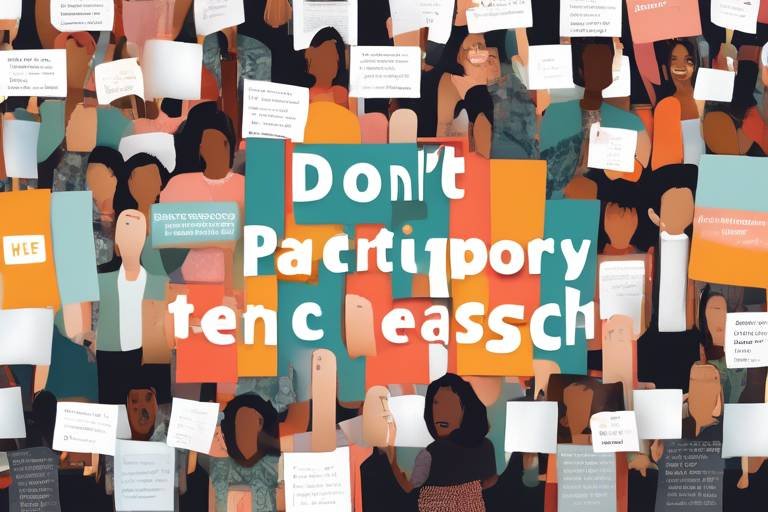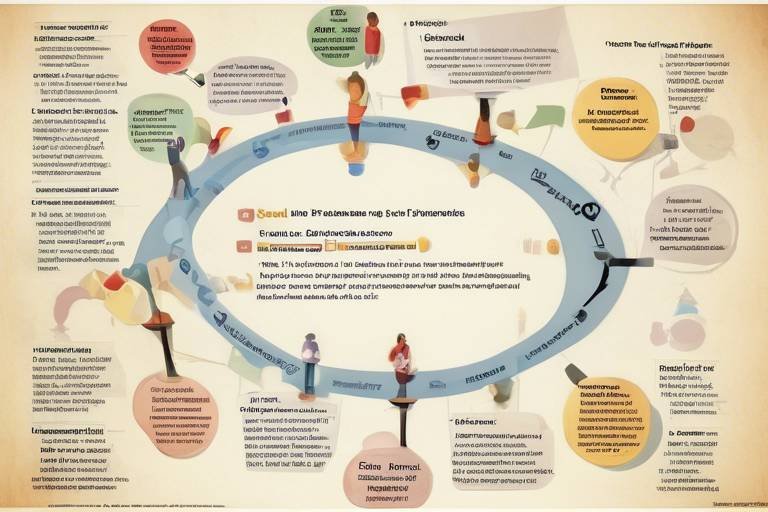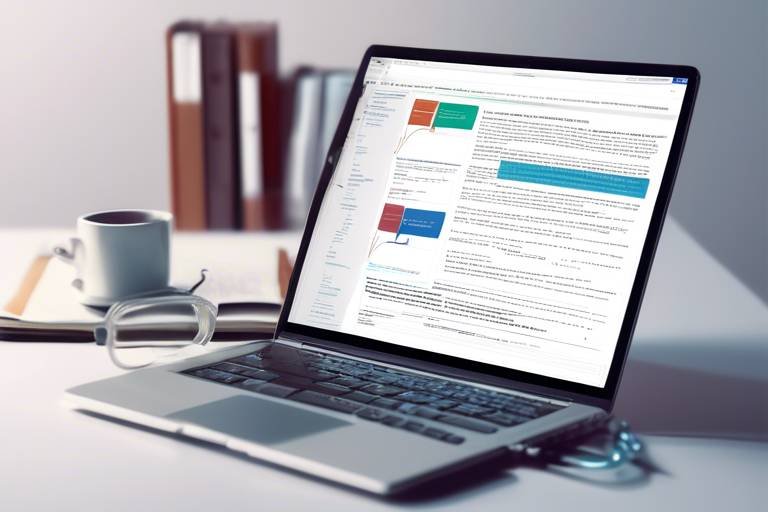The Benefits of Participatory Action Research
Participatory Action Research (PAR) is more than just a research methodology; it's a transformative approach that bridges the gap between research and community engagement. This innovative framework invites individuals from various backgrounds to actively participate in the research process, creating a dynamic environment where knowledge is co-created. Imagine a world where local voices shape the research agenda, driving real change in their communities. In this article, we will explore the myriad benefits of PAR, particularly its collaborative nature, and how it can catalyze positive outcomes in fields such as education, community development, and social justice.
One of the most profound benefits of Participatory Action Research is its ability to empower participants. By involving individuals directly in the research process, PAR fosters a sense of ownership that is often missing in traditional research methods. Participants are not merely subjects; they become active contributors, which encourages them to engage deeply with the issues at hand. This active participation can lead to personal growth and a greater understanding of their own community dynamics. When individuals feel empowered, they are more likely to take initiative, advocate for change, and contribute to meaningful solutions. It’s like giving someone the keys to their own destiny—suddenly, they have the power to drive change in their lives and communities.
The collaborative nature of PAR also results in enhanced data quality. When participants share their unique perspectives, the data collected becomes richer and more nuanced. Traditional research often relies on a top-down approach, where researchers dictate the terms of inquiry. In contrast, PAR creates a space where multiple voices are heard, leading to a comprehensive understanding of the issues being studied. This diversity of input not only improves the overall quality of research findings but also ensures that the results are relevant and applicable to the community. Think of it as a tapestry woven from many threads, each contributing to a more vibrant and complete picture of reality.
Community involvement is crucial in PAR, as it ensures that research addresses real-world problems. Engaging local stakeholders helps to align research objectives with community needs, enhancing relevance and impact. When researchers collaborate with community members, they can identify pressing issues that might not be visible from an outsider's perspective. This synergy makes the research process not just about gathering data, but about fostering relationships and building trust. It’s like having a GPS that not only tells you where to go but also understands the roadblocks and detours along the way.
Building trust between researchers and participants is essential for effective collaboration. Trust fosters open communication, encourages honest feedback, and ultimately leads to more successful research outcomes. When participants feel safe to share their thoughts and experiences, the quality of the data improves significantly. This trust can be cultivated through consistent engagement, transparency in the research process, and a genuine commitment to addressing community concerns. It’s akin to planting a seed; with time, care, and nurturing, it can grow into a robust relationship that benefits everyone involved.
Establishing long-term relationships between researchers and communities can facilitate ongoing dialogue and collaboration. This creates a sustainable framework for continued research and development efforts. Rather than viewing research as a one-time event, PAR encourages a continuous cycle of inquiry and action. These enduring relationships help maintain momentum and ensure that the insights gained from the research are applied effectively. Picture it as a partnership where both parties are invested in each other's success, creating a ripple effect of positive change.
PAR promotes capacity building by equipping participants with skills and knowledge throughout the research process. This empowerment leads to enhanced community resilience and self-sufficiency. By involving community members in the research, they not only contribute to the findings but also gain valuable skills that can be applied beyond the project. This dual benefit reinforces the idea that research can be a powerful tool for personal and community development. It’s like teaching someone to fish rather than just giving them a fish; they learn to sustain themselves over the long term.
Participatory Action Research often addresses power imbalances and social injustices. By involving marginalized voices, PAR works toward equitable solutions and promotes social change, making it a vital tool for advocacy. The traditional research landscape can sometimes overlook the needs of the most vulnerable populations. However, through PAR, these voices are amplified, ensuring that their concerns are not only heard but also prioritized in the research agenda. This commitment to social justice makes PAR not just a methodology but a movement toward a more equitable society.
PAR serves as a platform for advocacy, allowing marginalized groups to voice their concerns and influence decision-making processes. This can lead to more inclusive policies and practices that reflect the actual needs of the community. When marginalized voices are included in the research process, they can challenge existing power structures and advocate for change. It’s like handing them a megaphone, allowing them to speak up and be heard in the halls of power.
The findings from Participatory Action Research can significantly influence policy development. Engaging stakeholders ensures that research outcomes are considered in decision-making, promoting evidence-based policies that reflect community needs. When policymakers listen to the voices of those directly affected by their decisions, they are more likely to create solutions that are effective and sustainable. This creates a feedback loop where research informs policy, and policy, in turn, shapes further research, leading to a cycle of continuous improvement.
- What is Participatory Action Research? PAR is a collaborative research approach that involves participants in the research process, aiming to create actionable knowledge and foster social change.
- How does PAR benefit communities? PAR empowers community members, enhances data quality, and promotes social justice by involving marginalized voices in the research process.
- Can PAR influence policy? Yes, the findings from PAR can significantly impact policy development by ensuring that research outcomes reflect community needs.
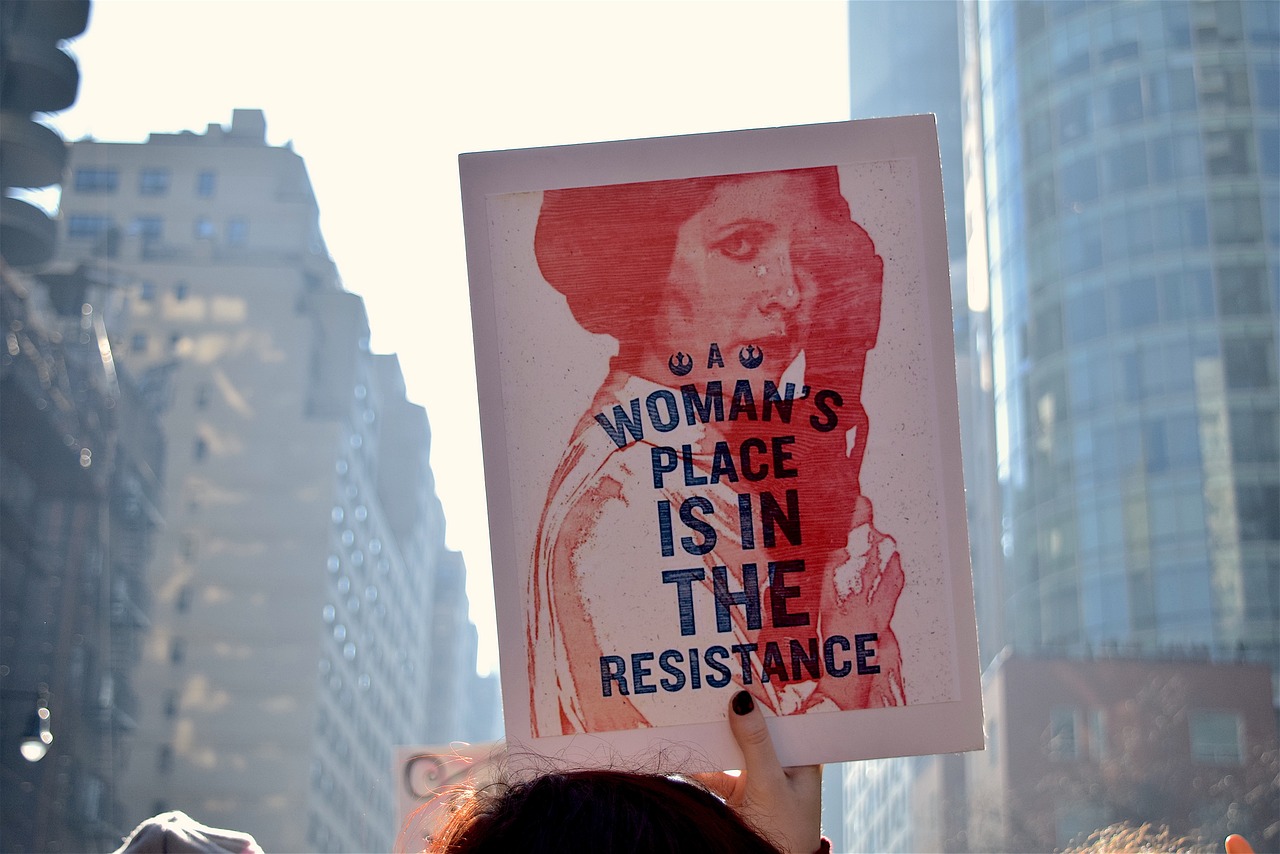
Empowerment of Participants
This article explores the advantages of Participatory Action Research (PAR), emphasizing its collaborative approach and transformative potential in various fields, including education, community development, and social justice.
Participatory Action Research (PAR) is a game-changer when it comes to empowering individuals. Imagine being part of a process where your voice matters, where your insights shape the direction of research. That's the essence of PAR! By actively involving participants in the research journey, it fosters a profound sense of ownership and responsibility. This isn't just about gathering data; it's about creating a community of engaged individuals who contribute to the narrative of their own lives.
When participants are given the opportunity to share their experiences and perspectives, they often discover strengths they didn’t know they had. This process can lead to personal growth that transcends the research itself. Think of it as a ripple effect: one person's empowerment can inspire others, creating a wave of positive change. Here are a few ways PAR empowers individuals:
- Ownership: Participants feel a sense of ownership over the research process, which boosts their confidence and commitment.
- Skill Development: Engaging in PAR helps individuals develop critical skills such as data collection, analysis, and communication.
- Community Building: The collaborative nature of PAR fosters relationships and solidarity among participants.
Moreover, the empowerment extends beyond the individual level. When groups come together to address shared issues, they cultivate a collective identity that strengthens community bonds. This collaborative spirit not only makes the research more relevant but also enhances the likelihood of meaningful outcomes. As participants share their stories, they help highlight the nuances of their experiences, bringing depth to the research findings.
In essence, PAR transforms participants from passive subjects into active agents of change. This shift is not just beneficial for the research itself; it has profound implications for the participants' lives. By being part of the research process, they gain insights into their own circumstances, learn to articulate their needs, and become advocates for their communities. It's a powerful reminder that when people are given the tools and opportunities to contribute, they can drive change in ways that are both impactful and lasting.
The collaborative nature of PAR often results in richer, more nuanced data. Participants contribute their unique perspectives, leading to a comprehensive understanding of the issues being studied and improving the overall quality of research findings.
Community involvement is crucial in PAR, as it ensures that research addresses real-world problems. Engaging local stakeholders helps to align research objectives with community needs, enhancing relevance and impact.
Building trust between researchers and participants is essential for effective collaboration. Trust fosters open communication, encourages honest feedback, and ultimately leads to more successful research outcomes.
Establishing long-term relationships between researchers and communities can facilitate ongoing dialogue and collaboration, creating a sustainable framework for continued research and development efforts.
PAR promotes capacity building by equipping participants with skills and knowledge throughout the research process. This empowerment can lead to enhanced community resilience and self-sufficiency.
Participatory Action Research often addresses power imbalances and social injustices. By involving marginalized voices, PAR works toward equitable solutions and promotes social change, making it a vital tool for advocacy.
PAR serves as a platform for advocacy, allowing marginalized groups to voice their concerns and influence decision-making processes. This can lead to more inclusive policies and practices.
The findings from Participatory Action Research can significantly influence policy development. Engaging stakeholders ensures that research outcomes are considered in decision-making, promoting evidence-based policies that reflect community needs.
- What is Participatory Action Research?
Participatory Action Research (PAR) is an approach that involves participants actively in the research process, focusing on collaboration and social change. - How does PAR empower individuals?
PAR empowers individuals by involving them in the research, fostering a sense of ownership, and encouraging personal growth through skill development and community engagement. - What are the benefits of community involvement in PAR?
Community involvement ensures that research addresses real-world problems, enhances relevance, and leads to more impactful outcomes.

Enhanced Data Quality
Participatory Action Research (PAR) is a game-changer when it comes to data quality. Unlike traditional research methods that often rely solely on the researcher’s perspective, PAR invites participants to share their insights and experiences. This collaborative approach not only enriches the data collected but also ensures that it reflects the real-world context of the issues being studied. Think of it like a potluck dinner: everyone brings their unique dish to the table, creating a diverse and flavorful spread of information that no single person could offer alone.
One of the most significant advantages of PAR is that it promotes a deeper understanding of complex social issues. Participants contribute their unique perspectives, which leads to a more comprehensive understanding of the challenges faced by the community. This is particularly important in fields like education, community development, and social justice, where the stakes are high, and the nuances can be easily overlooked. When participants are actively involved in the research process, they help identify critical areas that need attention, which can lead to more effective solutions.
Moreover, the data collected through PAR tends to be richer and more nuanced. For instance, when researchers engage with community members, they can uncover hidden stories and insights that might not surface through surveys or interviews conducted in isolation. This engagement often leads to qualitative data that adds depth to the quantitative findings, creating a more holistic view of the situation. Here’s how this can manifest:
| Type of Data | Traditional Research | Participatory Action Research |
|---|---|---|
| Quantitative | Standardized surveys | Tailored surveys co-created with participants |
| Qualitative | Interviews by researchers | Focus groups with community input |
| Contextual | Limited to researcher’s perspective | Rich narratives and local insights |
This table illustrates how the different approaches to data collection can impact the quality and relevance of the findings. In PAR, the emphasis on collaboration ensures that the data is not only more accurate but also more reflective of the community’s voice. This is crucial for driving meaningful change, as policies and interventions based on rich, contextually relevant data are more likely to succeed.
Additionally, the iterative nature of PAR allows for continuous feedback and adaptation throughout the research process. As participants engage with the data, they can provide insights that lead to adjustments in the research design or focus. This adaptability is key to ensuring that the research remains relevant and responsive to the community's needs.
In conclusion, the enhanced data quality achieved through Participatory Action Research is a direct result of its collaborative nature. By involving participants in every step of the research process, PAR not only enriches the data collected but also fosters a sense of ownership and agency among community members. This ultimately leads to research outcomes that are not just academically sound but also deeply connected to the realities of the people they aim to serve.
- What is Participatory Action Research? PAR is a collaborative research approach that actively involves participants in the research process to address real-world issues.
- How does PAR improve data quality? By incorporating diverse perspectives, PAR enriches the data collected, leading to a more comprehensive understanding of the issues at hand.
- Can PAR be used in different fields? Yes, PAR is applicable in various fields, including education, community development, and social justice.
- What are the benefits of participant involvement? Participant involvement fosters a sense of ownership, encourages active engagement, and results in more meaningful outcomes.

Community Involvement
Community involvement is at the very heart of Participatory Action Research (PAR). Imagine a vibrant tapestry where each thread represents a unique voice, perspective, and experience. When communities are actively engaged in the research process, it ensures that the issues being studied are not just abstract concepts but real-world challenges that affect their daily lives. This engagement transforms the research from a mere academic exercise into a powerful tool for change.
By involving local stakeholders, researchers can align their objectives with the actual needs of the community. This alignment is crucial because it enhances the relevance and impact of the research. Participants bring their lived experiences, insights, and cultural contexts into the conversation, creating a richer and more nuanced understanding of the issues at hand. This collaborative approach is not just about collecting data; it’s about fostering a sense of shared purpose and collective action.
Moreover, community involvement in PAR can lead to unexpected benefits. For example, when community members are part of the research process, they often discover new strengths and capabilities within themselves. This can be likened to planting seeds in a garden; with the right nurturing, those seeds can grow into robust plants that contribute to the ecosystem. Similarly, engaged participants develop skills, build confidence, and become advocates for their own communities.
To illustrate the importance of community involvement in PAR, consider the following points:
- Real-world relevance: Research that reflects the community's actual concerns is more likely to lead to meaningful solutions.
- Empowerment: Involvement in research processes empowers community members, giving them a stake in the outcomes.
- Shared ownership: When communities feel ownership over the research, they are more invested in the results and implementation of findings.
In conclusion, community involvement is not just a component of Participatory Action Research; it is the foundation that supports the entire structure. By engaging with the community, researchers can ensure that their work is not only relevant and impactful but also transformative. This collaborative spirit fosters a sense of unity and shared goals, ultimately leading to sustainable change that resonates long after the research has concluded.
Q1: What is Participatory Action Research (PAR)?
A1: PAR is a collaborative research approach that involves stakeholders in the research process, promoting shared ownership and addressing real-world issues.
Q2: How does community involvement enhance the research process?
A2: Community involvement ensures that research addresses relevant issues, incorporates diverse perspectives, and fosters empowerment among participants.
Q3: What are some benefits of engaging marginalized communities in PAR?
A3: Engaging marginalized communities helps to address power imbalances, promotes social justice, and leads to more inclusive policies and practices.

Building Trust
Building trust is the cornerstone of successful Participatory Action Research (PAR). When researchers and participants come together, they’re not just exchanging information; they’re forging a bond that can lead to transformative outcomes. Imagine a bridge being built between two islands—each side represents the researchers and the community. The stronger the bridge, the more traffic it can handle, leading to greater collaboration and understanding. Trust acts as the foundation of this bridge, ensuring that both parties feel secure in sharing their thoughts, experiences, and insights.
Trust fosters an environment where open communication can flourish. When participants feel that their voices are valued and that their contributions matter, they are more likely to engage authentically in the research process. This authenticity is essential because it encourages participants to share their true perspectives and experiences, which can significantly enhance the quality and depth of the data collected. Without trust, participants may hold back, leading to incomplete or biased information that can skew research findings.
Moreover, building trust involves a commitment to transparency. Researchers need to be clear about their intentions, methodologies, and how the data will be used. This transparency not only reassures participants but also empowers them to take an active role in the research. For instance, when researchers share preliminary findings with participants, it opens up avenues for feedback and discussion, reinforcing the collaborative spirit of PAR.
Additionally, trust is cultivated over time through consistent engagement and respect. Researchers should strive to understand the cultural and social contexts of the communities they work with. This means being present, listening actively, and showing genuine interest in the participants' lives and challenges. When participants see that researchers are committed to their well-being and respect their knowledge, trust naturally develops.
In summary, trust is not just a nice-to-have; it’s a necessity for the success of Participatory Action Research. By fostering an atmosphere of openness, transparency, and respect, researchers can create a collaborative environment where participants feel empowered to share their insights. This, in turn, leads to richer data, more meaningful outcomes, and a stronger community-researcher relationship. As we navigate the complexities of social issues through PAR, let’s remember that trust is the glue that holds this partnership together.
- What is Participatory Action Research?
Participatory Action Research (PAR) is a collaborative research approach that actively involves participants in the research process, aiming to address real-world issues and promote social change. - How does PAR empower participants?
PAR empowers participants by involving them in decision-making, fostering a sense of ownership, and equipping them with skills and knowledge throughout the research process. - Why is trust important in PAR?
Trust is crucial in PAR as it encourages open communication, honest feedback, and collaboration, leading to more successful and impactful research outcomes. - How can researchers build trust with communities?
Researchers can build trust by being transparent, actively listening, respecting participants' perspectives, and consistently engaging with the community over time.

Long-term Relationships
Establishing between researchers and communities is one of the cornerstones of Participatory Action Research (PAR). These relationships are not just about gathering data; they are about fostering a deep sense of trust and collaboration that can lead to transformative outcomes for everyone involved. Imagine a garden where seeds are planted not just for a single season but for years to come. Just as a gardener tends to their plants, researchers must nurture these relationships to ensure that the community's needs are continuously met and understood.
When researchers commit to working with communities over an extended period, they create a space for ongoing dialogue and collaboration. This continuous engagement allows for the evolution of research questions and objectives based on the changing needs of the community. For instance, if a community faces a sudden challenge, such as a natural disaster, researchers who have established trust and rapport can pivot their focus to address these urgent needs. This adaptability is crucial in ensuring that research remains relevant and impactful.
Moreover, long-term relationships contribute to the sustainability of research efforts. When communities are involved in the research process over time, they gain valuable skills and knowledge that empower them to take charge of their own development. This capacity building is akin to teaching someone to fish rather than just giving them a fish; it leads to self-sufficiency and resilience. As participants become more knowledgeable, they can advocate for their own needs and drive change within their communities.
To illustrate the benefits of these long-term partnerships, consider the following table that outlines key advantages:
| Advantage | Description |
|---|---|
| Trust Building | Long-term engagement fosters a deeper level of trust, encouraging open communication and honest feedback. |
| Community Empowerment | Participants gain skills and knowledge, leading to enhanced self-sufficiency and resilience. |
| Adaptability | Researchers can quickly adapt to emerging community needs, ensuring relevance and impact. |
| Sustainable Change | Long-term relationships create a framework for continuous improvement and development. |
In essence, the power of long-term relationships in Participatory Action Research cannot be overstated. They create a symbiotic relationship where both researchers and communities benefit, leading to more effective and meaningful research outcomes. As we continue to explore the transformative potential of PAR, let us remember that the seeds of change are often planted in the soil of collaboration and trust.
- What is Participatory Action Research?
Participatory Action Research (PAR) is a collaborative research approach that involves participants actively in the research process, focusing on real-world issues and social change. - How does PAR empower communities?
PAR empowers communities by involving them in the research process, giving them a voice, and helping them develop skills and knowledge to address their own challenges. - Why are long-term relationships important in PAR?
Long-term relationships foster trust, adaptability, and sustainability, ensuring that research remains relevant and impactful over time. - Can PAR influence policy?
Yes, findings from PAR can significantly influence policy development by providing evidence-based insights that reflect community needs.
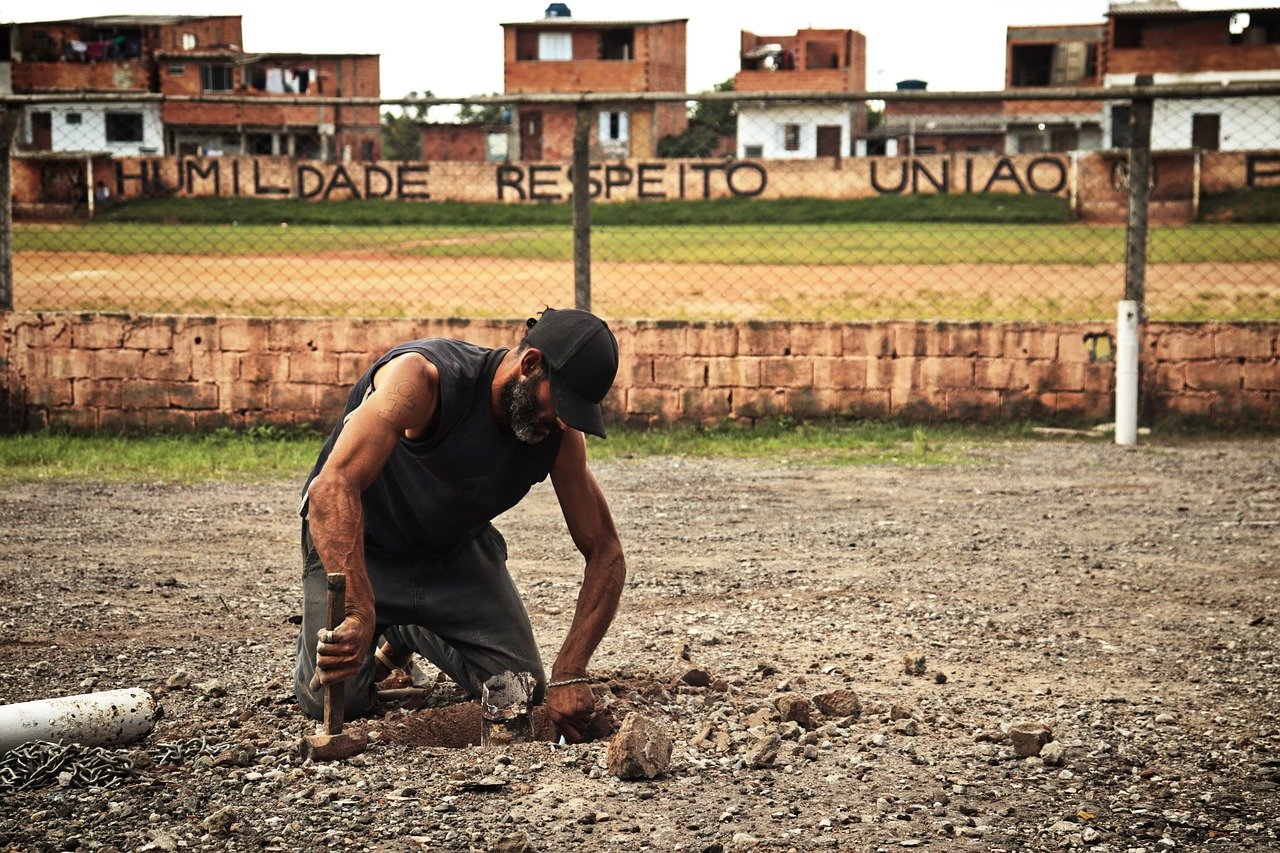
Capacity Building
Participatory Action Research (PAR) is not just about gathering data; it’s fundamentally about empowering individuals and communities through capacity building. When participants engage in the research process, they are not merely subjects; they become active contributors. This involvement equips them with essential skills and knowledge that can be applied beyond the confines of the project. Imagine a community learning to analyze their own issues, developing solutions, and implementing change. This transformation is at the heart of capacity building.
One of the most significant advantages of PAR is that it fosters a culture of learning. Participants are encouraged to explore, question, and experiment, which leads to a deeper understanding of their challenges and the tools available to address them. For example, community members might learn how to collect data, analyze results, and present their findings. This knowledge not only enhances their individual capabilities but also strengthens the community as a whole.
Furthermore, the skills developed through PAR can lead to increased community resilience. When participants are equipped with the tools to identify problems, assess their needs, and advocate for themselves, they become more self-sufficient. This self-sufficiency is crucial in today’s rapidly changing world, where communities must adapt to various social, economic, and environmental challenges. In essence, capacity building through PAR creates a cycle of empowerment: as participants grow, so does the community's ability to effect change.
To illustrate the impact of capacity building in PAR, consider the following table that outlines the key skills participants develop:
| Skill Developed | Description |
|---|---|
| Data Collection | Participants learn methods for gathering qualitative and quantitative data relevant to their community issues. |
| Critical Thinking | Engaging in research encourages participants to analyze situations, question assumptions, and develop informed opinions. |
| Communication | Participants enhance their ability to articulate their findings and advocate for their needs effectively. |
| Collaboration | Working together on research projects fosters teamwork and strengthens community bonds. |
In summary, capacity building through Participatory Action Research is a transformative process that not only addresses immediate community needs but also prepares individuals for future challenges. By investing in the skills and knowledge of participants, PAR creates a ripple effect that enhances the overall health and vitality of communities. This empowerment is not just beneficial for the present; it lays the groundwork for a sustainable future where communities can thrive independently.
- What is Participatory Action Research?
Participatory Action Research (PAR) is a collaborative research approach that actively involves participants in the research process, allowing them to contribute to and influence the outcomes.
- How does PAR promote capacity building?
PAR promotes capacity building by empowering participants with skills and knowledge, encouraging them to analyze their issues, and equipping them to advocate for themselves.
- Can PAR lead to long-term community benefits?
Yes, the skills and knowledge gained through PAR can lead to increased resilience and self-sufficiency, benefiting the community in the long run.

Improved Social Justice
Participatory Action Research (PAR) is more than just a research methodology; it’s a powerful catalyst for social change. At its core, PAR seeks to address the underlying power imbalances that exist within society. By actively involving marginalized communities in the research process, PAR ensures that their voices are not only heard but also valued. Imagine a world where everyone, regardless of their background, has a say in the decisions that affect their lives. This is the transformative potential of PAR in the realm of social justice.
One of the most significant advantages of PAR is its ability to spotlight the issues that often go unnoticed. When researchers collaborate with community members, they gain insights that are deeply rooted in the lived experiences of those who are typically sidelined. This approach leads to a more comprehensive understanding of the challenges faced by these communities, paving the way for solutions that are both relevant and effective. For instance, when addressing issues like housing instability or access to education, the unique perspectives of community members can illuminate the nuances that traditional research methods might overlook.
Furthermore, PAR serves as a platform for advocacy. It empowers marginalized groups to voice their concerns and actively participate in the decision-making processes that impact their lives. This is crucial because policy changes often stem from data that reflects the realities of those affected. By including the voices of the marginalized in research, PAR helps to create a more equitable landscape where policies are informed by the actual needs of the community rather than assumptions made by outsiders. The result? More inclusive policies that truly reflect the desires and requirements of the people they aim to serve.
In addition to influencing policy, PAR also fosters a sense of community ownership over the research process. When individuals see their contributions making a tangible difference, it cultivates a deeper connection to the outcomes of the research. This sense of ownership not only motivates continued participation but also enhances the overall impact of the research findings. Communities are more likely to advocate for changes when they feel a personal stake in the results.
The journey toward improved social justice through PAR is not without its challenges. Building trust between researchers and participants is essential; without trust, the collaboration can falter. Researchers must approach communities with humility and a genuine desire to learn, rather than impose their ideas. This relationship-building is a gradual process that requires consistent effort and transparency.
Ultimately, the impact of PAR on social justice can be profound. It not only addresses immediate concerns but also lays the groundwork for long-term change. By equipping communities with the tools to continue advocating for themselves, PAR fosters resilience and self-sufficiency. The ripple effects of this empowerment can lead to a more just society where everyone has the opportunity to thrive.
- What is Participatory Action Research?
Participatory Action Research is a collaborative research approach that involves community members in the research process, aiming to address social issues and empower participants. - How does PAR improve social justice?
PAR improves social justice by amplifying the voices of marginalized groups, ensuring their concerns are included in decision-making and policy development. - What are the benefits of involving community members in research?
Involving community members leads to richer data, a better understanding of issues, and solutions that are more relevant and effective. - Can PAR influence policy?
Yes, findings from PAR can significantly influence policy by providing evidence-based insights that reflect community needs.

Advocacy for Marginalized Groups
Participatory Action Research (PAR) is not just a method; it’s a powerful platform for advocacy that gives a voice to those who are often unheard. Imagine a community where the concerns and needs of every individual are acknowledged, where the marginalized can step into the spotlight and express their challenges. This is the essence of PAR. By actively involving marginalized groups in the research process, PAR ensures that their perspectives shape the discourse around policies and practices that affect their lives.
One of the most profound impacts of PAR is its ability to create a space for dialogue. When researchers collaborate with community members, they don’t just gather data; they build relationships. This collaborative spirit fosters an environment where participants feel safe to share their stories, experiences, and aspirations. It’s like planting seeds in a garden; with care and attention, those seeds can grow into a lush landscape of understanding and change.
Furthermore, PAR facilitates the identification of specific issues that marginalized groups face, which might otherwise go unnoticed. For example, consider a community struggling with access to healthcare services. Through PAR, researchers can work alongside community members to document their experiences, highlight barriers, and advocate for necessary changes. This approach ensures that the data collected is not only relevant but also impactful.
Additionally, the advocacy potential of PAR extends to influencing policies. When marginalized voices are included in the research process, the findings can directly inform decision-makers. This is crucial because policies that are developed without input from affected communities often fail to address their actual needs. By presenting evidence that reflects the lived experiences of marginalized groups, PAR can pave the way for more inclusive and equitable policies.
Moreover, the empowerment of participants through PAR cannot be overstated. When individuals from marginalized backgrounds are involved in the research, they gain valuable skills and knowledge that can enhance their ability to advocate for themselves and their communities. This empowerment is a vital component of social justice, as it transforms participants from passive subjects into active agents of change.
In summary, Participatory Action Research serves as a crucial tool for advocacy, enabling marginalized groups to articulate their needs and influence the decision-making processes that affect their lives. By fostering collaboration, building trust, and promoting capacity building, PAR not only amplifies voices but also drives meaningful social change.
- What is Participatory Action Research?
Participatory Action Research is a collaborative research approach that involves stakeholders in the research process to address real-world issues and promote social change.
- How does PAR empower marginalized groups?
PAR empowers marginalized groups by involving them in the research process, allowing them to share their experiences and influence outcomes that affect their lives.
- Can PAR influence policy?
Yes, findings from Participatory Action Research can significantly influence policy development by providing evidence that reflects the needs and perspectives of marginalized communities.

Policy Influence
Participatory Action Research (PAR) has a profound impact on policy development, acting as a bridge between community needs and decision-making processes. When researchers engage with the community, they gather insights that are often overlooked in traditional research methods. This engagement ensures that the voices of those most affected by policies are not just heard but actively shape the outcomes. Imagine a world where policies are crafted not in isolation but through a vibrant dialogue between researchers and community members. That’s the transformative power of PAR!
One of the key strengths of PAR is its ability to produce evidence-based findings that resonate with real-world issues. When local stakeholders are involved in the research process, the data collected reflects their lived experiences, challenges, and aspirations. This makes the findings not only relevant but also compelling for policymakers. They are more likely to consider recommendations that are grounded in the realities of the communities they serve.
Furthermore, the collaborative nature of PAR fosters a sense of ownership among participants, who become advocates for the changes they wish to see. This advocacy is crucial when it comes to influencing policy. When community members are equipped with data and narratives that highlight their needs, they can effectively engage with policymakers, ensuring that their voices are prioritized in discussions. For instance, a community that has identified a lack of educational resources can present their findings to local authorities, advocating for policy changes that address this gap.
In addition to direct advocacy, the findings from PAR can lead to the establishment of policy frameworks that are more inclusive and equitable. By systematically addressing issues such as social injustice and power imbalances, PAR helps to create policies that not only serve the majority but also uplift marginalized groups. This is especially vital in sectors like education, healthcare, and housing, where disparities often exist.
To illustrate the potential of PAR in influencing policy, consider the following table that highlights key areas where PAR has made a significant impact:
| Area of Impact | Example of PAR Influence | Outcome |
|---|---|---|
| Education | Community-led assessments of school needs | Increased funding for under-resourced schools |
| Healthcare | Research on access to health services | Policy changes to improve healthcare access for low-income families |
| Housing | Community studies on housing discrimination | Legislation to protect tenants’ rights |
In conclusion, the influence of Participatory Action Research on policy is undeniable. By ensuring that research is grounded in the realities of the community, PAR not only enhances the quality of the data but also empowers participants to advocate for their needs. This collaborative approach leads to more relevant, effective, and equitable policies that can transform lives and communities.
- What is Participatory Action Research?
Participatory Action Research is a collaborative research approach that actively involves participants in the research process to address real-world issues. - How does PAR influence policy?
PAR influences policy by providing evidence-based findings that reflect community needs, empowering participants to advocate for change. - Who benefits from Participatory Action Research?
Both the researchers and the community benefit; researchers gain deeper insights, while community members gain skills and a voice in decision-making. - Can PAR be used in various fields?
Yes, PAR is applicable in fields such as education, healthcare, community development, and social justice.
Frequently Asked Questions
- What is Participatory Action Research (PAR)?
Participatory Action Research (PAR) is a collaborative research approach that actively involves participants in the research process. It emphasizes the importance of community engagement and seeks to address real-world issues by empowering individuals to take part in the research that affects their lives.
- How does PAR empower participants?
PAR empowers participants by giving them a voice in the research process. When individuals are involved in shaping the research, they develop a sense of ownership and responsibility, which can lead to personal growth and more meaningful outcomes for the community.
- What are the benefits of enhanced data quality in PAR?
The collaborative nature of PAR often results in richer and more nuanced data. Participants bring their unique perspectives, leading to a comprehensive understanding of the issues being studied. This not only improves the overall quality of research findings but also ensures that the data reflects the realities of the community.
- Why is community involvement crucial in PAR?
Community involvement is essential in PAR because it ensures that the research addresses real-world problems. By engaging local stakeholders, researchers can align their objectives with the community’s needs, enhancing the relevance and impact of the research.
- How does PAR build trust between researchers and participants?
Building trust is key in PAR. When researchers and participants communicate openly and honestly, it fosters a collaborative environment. Trust encourages feedback and dialogue, which ultimately leads to more successful research outcomes and deeper relationships.
- What role does capacity building play in PAR?
Capacity building in PAR involves equipping participants with skills and knowledge during the research process. This empowerment enhances community resilience and self-sufficiency, enabling participants to tackle challenges even after the research is complete.
- How does PAR contribute to social justice?
PAR addresses power imbalances and social injustices by involving marginalized voices. It aims for equitable solutions and promotes social change, making it a vital tool for advocacy and ensuring that everyone has a say in the decisions that affect their lives.
- Can PAR influence policy development?
Yes, the findings from PAR can significantly influence policy development. By engaging stakeholders throughout the research process, PAR ensures that the outcomes are considered in decision-making, promoting evidence-based policies that reflect the needs and priorities of the community.

